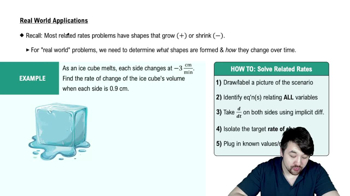Table of contents
- 0. Functions7h 52m
- Introduction to Functions16m
- Piecewise Functions10m
- Properties of Functions9m
- Common Functions1h 8m
- Transformations5m
- Combining Functions27m
- Exponent rules32m
- Exponential Functions28m
- Logarithmic Functions24m
- Properties of Logarithms34m
- Exponential & Logarithmic Equations35m
- Introduction to Trigonometric Functions38m
- Graphs of Trigonometric Functions44m
- Trigonometric Identities47m
- Inverse Trigonometric Functions48m
- 1. Limits and Continuity2h 2m
- 2. Intro to Derivatives1h 33m
- 3. Techniques of Differentiation3h 18m
- 4. Applications of Derivatives2h 38m
- 5. Graphical Applications of Derivatives6h 2m
- 6. Derivatives of Inverse, Exponential, & Logarithmic Functions2h 37m
- 7. Antiderivatives & Indefinite Integrals1h 26m
- 8. Definite Integrals4h 44m
- 9. Graphical Applications of Integrals2h 27m
- 10. Physics Applications of Integrals 2h 22m
4. Applications of Derivatives
Related Rates
Problem 3a
Textbook Question
If two opposite sides of a rectangle increase in length, how must the other two opposite sides change if the area of the rectangle is to remain constant?
 Verified step by step guidance
Verified step by step guidance1
Start by recalling the formula for the area of a rectangle, which is given by \( A = l \times w \), where \( l \) is the length and \( w \) is the width.
Since the area \( A \) is to remain constant, we can express this as \( l_1 \times w_1 = l_2 \times w_2 \), where \( l_1 \) and \( w_1 \) are the original dimensions, and \( l_2 \) and \( w_2 \) are the new dimensions.
If two opposite sides (say the lengths) increase, then \( l_2 > l_1 \). To keep the area constant, the product \( l_2 \times w_2 \) must equal \( l_1 \times w_1 \).
To maintain the equality, the width \( w_2 \) must decrease such that \( w_2 = \frac{l_1 \times w_1}{l_2} \). This ensures that the product of the new dimensions equals the original area.
Thus, as the length increases, the width must decrease proportionally to maintain the constant area of the rectangle.
 Verified video answer for a similar problem:
Verified video answer for a similar problem:This video solution was recommended by our tutors as helpful for the problem above
Video duration:
3mPlay a video:
Was this helpful?
Key Concepts
Here are the essential concepts you must grasp in order to answer the question correctly.
Area of a Rectangle
The area of a rectangle is calculated by multiplying its length by its width (A = l × w). This fundamental formula is crucial for understanding how changes in the dimensions of the rectangle affect its overall area. If one dimension increases, the other must adjust to maintain a constant area.
Recommended video:

Estimating the Area Under a Curve Using Left Endpoints
Inverse Relationship
An inverse relationship occurs when one quantity increases while another decreases, such that their product remains constant. In the context of the rectangle, if the lengths of two opposite sides increase, the lengths of the other two sides must decrease proportionally to keep the area unchanged.
Recommended video:

Inverse Cosine
Proportionality
Proportionality refers to the relationship between two quantities where a change in one quantity results in a corresponding change in another. In this scenario, the lengths of the opposite sides of the rectangle are proportional to each other, meaning that if one pair of sides increases, the other pair must decrease in a specific ratio to maintain the constant area.
Related Videos
Related Practice






